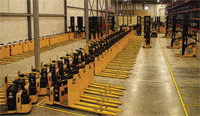green grocer

When Central Grocers and Certified Grocers Midwest merged last year, one of the consequences was the need for a new distribution center to serve the combined networks.
The merged company, a memberowned wholesaler that continues to operate under the Central Grocers name, is now serving more than 400 independently owned grocery stores in Chicagoland and northwest Indiana—a big increase from what Central Grocers had served before. The merger also shifted the geography somewhat, adding to the need to open a new DC.
To serve its expanded customer base, the company opted to build an allnew DC, a 960,000-square-foot facility in Joliet, Ill. That facility opened last month.
Building from scratch gave the company the opportunity to look at the technologies it would employ in the building with fresh eyes. As a result, it made several choices that not only are economically advantageous, but environmentally friendly as well.
Take, for example, the lift trucks the new facility is using.
The Central Grocers DC will be one of the few in the nation whose entire lift truck fleet will operate with hydrogen fuel cells.
Two-stage conversion
The decision to go with fuel cells may seem unusual for a grocery distributor. Grocers, whose margins tend to be razor thin, are noted for the sharp pencils they bring to their purchasing. "The grocery industry runs on pennies," says Kal Anglewicz, president of Yale Equipment & Services, the Rosemont, Ill., dealer that's providing the lift trucks. "They cannot just do a green initiative unless it is cost justified."
But Central Grocers' analysis, along with tough negotiations, led to a deal that will pay off in longterm savings in operating costs, according to John Coari, vice president of operations for Central Grocers. Coari took time to discuss the new facility and the lift truck decision with DC VELOCITY while traveling between facilities in the scramble prior to the new building's opening.
During the analysis of what lift trucks the company would employ in the new facility and how they would be powered, Central Grocers managers looked at several alternative fuel options, Coari said. Eventually, they settled on hydrogen fuel cells and negotiated a deal with Plug Power, a developer of alternative energy products. Plug Power is supplying the facility with 220 of its GenDrive fuel cell units for use in the lift truck fleet.
The GenDrive units make use of compressed hydrogen gas converted from liquid hydrogen. The liquid hydrogen storage system and fueling stations were supplied by Air Products, a company that provides atmospheric and specialty gases to a variety of industries.
The trucks themselves are being converted to hydrogen fuel cells in two stages. The first phase included 140 Yale center-control pallet trucks. Those trucks went into operation with the GenDrive fuel cell units when the new DC opened in April. The fleet also includes 41 reach trucks, 30 standup counterbalanced trucks at the shipping and receiving docks, and five sit-down three-wheel trucks for the freezer and cooler operations. Those are battery-operated trucks that will be converted to fuel cells early next year. In the meantime, the batteries are being managed with Sackett Systems' HydraHandler battery handling system, which will be removed when the conversion is completed.
Central Grocers has outsourced fleet maintenance to Yale Equipment & Services, which has been a vendor to the grocer for more than 40 years. That includes maintaining the fuel cell units under a full maintenance contract.
No more lines
Despite the higher startup costs, Coari is confident that using fuel cells will yield longterm savings for Central Grocers. "Plug Power made it very attractive to go with them," he said. "The initial cost is higher, but we will make up the difference in labor savings."
In particular, labor productivity will improve, he explained, by eliminating the time workers take to exchange batteries in a traditional battery room operation. Typically, he said, a battery exchange takes between five and 15 minutes, and it's not unusual to have several operators waiting in line to switch out batteries. Refueling at hydrogen stations will take no more than five minutes, and sometimes as little as two minutes. The new DC currently has three hydrogen fueling stations located at strategic locations throughout the facility. Two more will be added when the other trucks are converted early next year.
In addition, Coari said, trucks operating on hydrogen fuel cells are more like internal combustion vehicles than battery trucks in that they operate at close to full power throughout the shift. With batteryoperated trucks (particularly those powered by directcurrent batteries), voltage drops as the day wears on, making the vehicles sluggish.
Finally, eliminating the need for a battery room has meant a more productive use of DC floor space.
Delayed gratification
All told, Central Grocers expects the savings to add up to $1.5 million over 10 years, most of that in the last five years.
Despite those impressive savings, the technology is not for everyone. For one thing, the initial acquisition cost is substantially higher for fuel cells than for batteryoperated trucks, Anglewicz says, which means the technology probably won't benefit smallscale operations. "From our perspective, you probably need a minimum of 50 to 75 trucks and a twoshift operation," he says. But for large fleets in operations that are willing to wait for a payback, fuel cells offer benefits in fast fueling times, operating efficiency, and perhaps reduced maintenance costs.
Related Articles

Copyright ©2024. All Rights ReservedDesign, CMS, Hosting & Web Development :: ePublishing